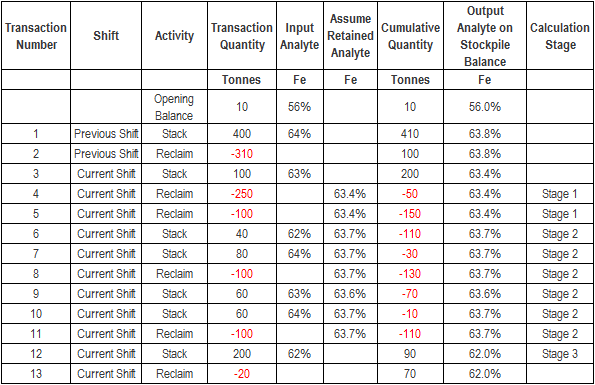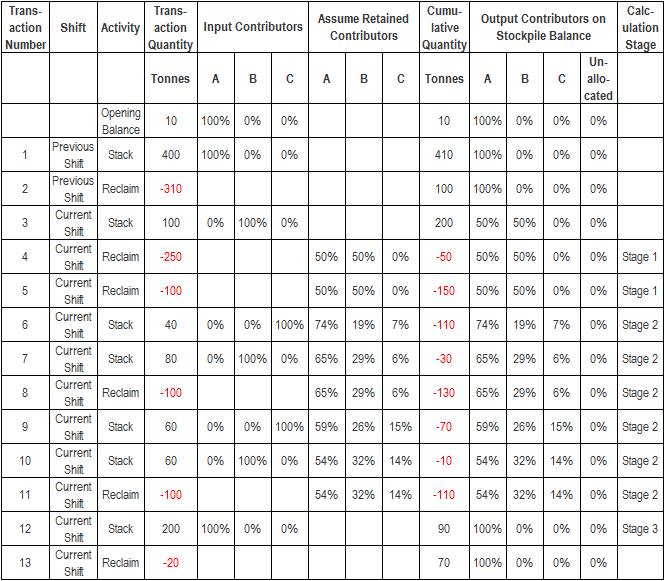Negative WAG Stockpile Example: Previous Period WAG, Start of Previous Shift
Analyte Calculations
There are three stages for the calculation of retained analyte quality on WAG stockpiles that go negative. The stages are as described in Negative WAG Stockpile Example: Previous Period WAG, No Shift Definition.
Example
The following table displays the transactions on a WAG stockpile. The configured Negative Method is Previous Period WAG, a Shift Definition is selected and the Date Option is Start Of Previous Shift.

Stage 1 begins with Transaction 4, when the stockpile balance becomes negative. The stockpile's analyte quality for iron was 63.4% after Transaction 3, so that value becomes the assumed analyte quality for the reclaim transactions in Stage 1.
Stage 2 begins with Transaction 6. Although this is a stacking transaction, the quantity is not enough to make the stockpile balance positive. The assumed analyte quality for iron becomes the weighted average of Transactions 1, 3 and 6, which have occurred since the beginning of the previous shift:
( 400 * 64% + 100 * 63% + 40 * 62% ) / ( 400 + 100 + 40 ) = 343.8 / 540 = 63.7%
Stage 2 continues with Transactions 7–12. New weighted average calculations are done for each stacking transaction. The reclaim transactions assume the analyte quality from the previous stockpile balance.
Stage 3 begins with Transaction 13, which is the first stacking transaction that makes the stockpile balance positive. The sampled analyte quality for iron on that transaction is 62%, and this becomes the analyte quality on the stockpile balance.
Contributor Calculations
There are three stages for the calculation of retained contributor values on WAG stockpiles that go negative. The stages are as described in the Previous Period WAG, No Shift Definition example.
Example
The following table displays the transactions on a WAG stockpile. The configured Negative Method is Previous Period WAG, a Shift Definition is selected and the Date Option is Start Of Previous Shift.

Stage 1 begins with Transaction 4, when the stockpile balance becomes negative. The stockpile's contributor values were A:50%, B:50% and C:0% after Transaction 3, so those values become the assumed contributor values for the reclaim transactions in Stage 1.
Stage 2 begins with Transaction 6. Although this is a stacking transaction, the quantity is not enough to make the stockpile balance positive. The assumed contributor values become the weighted average of Transactions 1, 3 and 6, which have occurred since the beginning of the previous shift. For Contributor A:
( 400 * 100% + 100 * 0% + 40 * 0% ) / ( 400 + 100 + 40 ) = 400 / 540 = 74%
Stage 2 continues with Transactions 7–12. New weighted average calculations are done for each stacking transaction. The reclaim transactions assume the contributor values from the previous stockpile balance.
Stage 3 begins with Transaction 13, which is the first stacking transaction that makes the stockpile balance positive. The sampled contributor values on that transaction are A:100%, B:0% and C:0%, and these become the contributor values on the stockpile balance.

